
Supplement A3: The Chemistry of Double-Bonded Functional Groups. Edited by Saul Patai Copyright 1997 John Wiley & Sons, Ltd.
ISBN: 0-471-95956-1
CHAPTER 20
Epoxidation of C=X double bonds
´ |
´ |
|
|
|
MIHALY BARTOK and GYULA SCHNEIDER |
|
|
||
Department of Organic Chemistry, Jozsef´ Attila University, Dom´ ter´ 8, |
|
|||
H-6720 Szeged, Hungary |
|
|
|
|
Fax: (36) 62-312-921 |
|
|
|
|
|
|
|
|
|
I. ABBREVIATIONS . . . . . . . . . . . . |
. . . . . . . . . |
. . . . . . . . . . . . . . . |
1223 |
|
II. INTRODUCTION . . . . . . . . . . . . . |
. . . . . . . . . . |
. . . . . . . . . . . . . . |
1224 |
|
III. EPOXIDATION OF THE CDC BOND |
. . . . . . . . . |
. . . . . . . . . . . . . . |
1224 |
|
A. Epoxidation by Peroxy Acids . . . |
. . . . . . . . . . |
. . . . . . . . . . . . . . |
1224 |
|
B. Metal-catalyzed Epoxidations . . . |
. . . . . . . . . . |
. . . . . . . . . . . . . . |
1227 |
|
1. Epoxidation by hydrogen peroxide . . . . . . . . |
. . . . . . . . . . . . . . |
1227 |
||
2. |
Epoxidation by hydroperoxides and other oxidants . . . . . . . . . . . |
1228 |
||
3. Asymmetric epoxidation . . . . . |
. . . . . . . . . . |
. . . . . . . . . . . . . . |
1230 |
|
4. |
Stereoselective and asymmetric epoxidation of allylic alcohols . . . . |
1233 |
||
C. Biological Epoxidations . . . . . . . |
. . . . . . . . . . |
. . . . . . . . . . . . . . |
1234 |
|
IV. EPOXIDATION OF THE CDO BOND |
. . . . . . . . . |
. . . . . . . . . . . . . . |
1235 |
|
A. Introduction . . . . . . . . . . . . . . . |
. . . . . . . . . . |
. . . . . . . . . . . . . . |
1235 |
|
B. Preparation of Dioxiranes . . . . . . |
. . . . . . . . . . |
. . . . . . . . . . . . . . |
1237 |
|
C. Epoxidations by Dioxiranes . . . . . . |
. . . . . . . . . |
. . . . . . . . . . . . . . |
1238 |
|
V. EPOXIDATION OF THE CDN BOND |
. . . . . . . . . |
. . . . . . . . . . . . . . |
1242 |
|
A. Introduction . . . . . . . . . . . . . . . . |
. . . . . . . . . |
. . . . . . . . . . . . . . |
1242 |
|
B. Preparation of Oxaziridines . . . . . . |
. . . . . . . . . |
. . . . . . . . . . . . . . |
1242 |
|
C. Reactions of Oxaziridines . . . . . . . |
. . . . . . . . . |
. . . . . . . . . . . . . . |
1245 |
|
VI. REFERENCES . . . . . . . . . . . . . . . . |
. . . . . . . . . |
. . . . . . . . . . . . . . |
1246 |
|
|
|
|
|
|
|
I. ABBREVIATIONS |
|
|
|
MCPBA |
m-chloroperoxybenzoic acid |
DET |
diethyl tartrate |
|
Bn |
benzyl |
(C)MPCA |
(C)-monoperoxycamphoric |
|
PTC |
phase transfer catalyst |
|
acid |
|
THF |
tetrahydrofuran |
oxone |
2KHSO5Ð KHSO4Ð K2SO4 |
|
TPP |
tetraphenylporphyrin |
|
|
|
1223
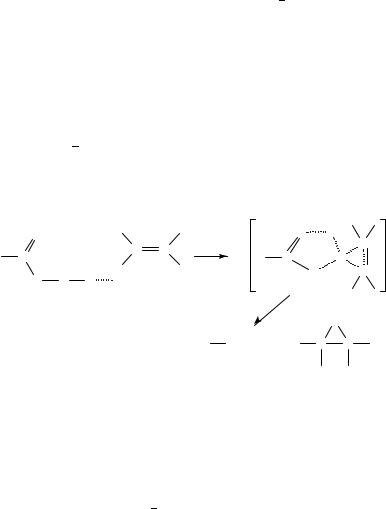
1224 |
Mihaly´ Bartok´ and Gyula Schneider |
II. INTRODUCTION
Epoxidation of CDX double bonds is a very active field in organic chemistry. It seems that for almost every type of double bond a special epoxidation reagent has been developed.
One can find quite a few cases of peroxy acids reacting for hours at elevated temperatures with simple alkenes in order to form regular epoxides. More deactivated olefins require lengthy treatment with strongly basic hydrogen peroxide solution.
There are many other reactions devised for oxygen transfer such as various oxidants combined with transition metals with or without macrocyclic hosts and industrial specific epoxidations using oxygen, to name just a few.
Because of the large number of literature data on epoxidations, we cannot hope to give a full review of all publications that have appeared. We shall therefore restrict ourselves to a brief survey of the still continuing research that has led to the currently accepted interpretation of epoxidations. Using earlier reviews1 10 as a starting point, we shall mainly discuss the results achieved in the last years. Here recent developments are described by presenting some characteristic new examples.
III.EPOXIDATION OF THE C=C BOND
A.Epoxidation by Peroxy Acids
The epoxidation of olefins by peroxycarboxylic acids is quite important and has been reviewed repeatedly2,6,9. The two characteristic features of epoxidations with peroxycarboxylic acids are such that the epoxidations are accelerated by both increasing electron density of the carbon carbon double bond and electron-attracting groups on the peroxycarboxylic acid.
In coordinating solvents, peroxycarboxylic acids form a complex with the solvent through intermolecular hydrogen bonding11. Thus, a well-known cyclic transition state has been widely accepted (equation 1).
|
O |
|
|
O |
H |
R |
+ |
C C |
C |
|
C |
C |
R |
|
O |
||
|
O O H |
solvent |
|
O |
C |
|
|
|
|
||
|
|
|
|
|
(1) |
|
|
|
|
|
O |
|
|
R CO2 H |
+ |
C |
C |
Solvent effects in the peroxycarboxylic acid epoxidations are significant. The epoxidation rates in ether or ethyl acetate are approximately one-tenth of those in benzene or chloroform. The much slower epoxidation with peroxycarboxylic acids with intermolecular hydrogen bonding is indicative of the development of a cyclic transition state.
It is known that peroxycarboxylic acids exist in an intramolecular hydrogen-bonded form in noncoordinating solvents and in an intermolecular hydrogen-bonded form in coordinating solvents such as ether12,13. When a coordinating group is present in an olefin, a directed epoxidation could be attained. A typical example is the syn epoxidation of acyclic and cyclic allyl alcohols14 17. It was postulated that a hydrogen bond formed
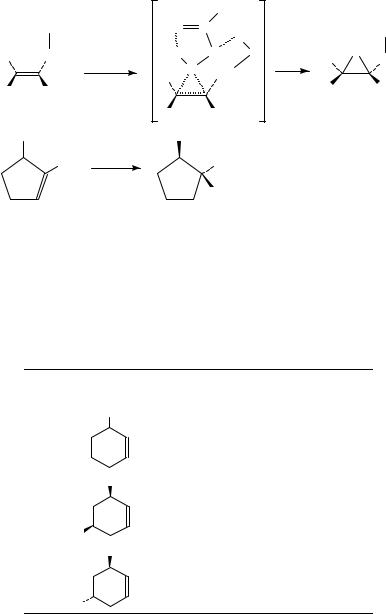
20. Epoxidation of CDX double bonds |
1225 |
between the hydroxyl group and one of the peracid oxygens leads to the delivery of the reagent to the olefin face syn to the hydroxyl group (equations 2 and 3).
|
|
|
R |
|
|
|
|
OH |
O |
C |
H |
|
OH |
|
|
|
|
|
||
|
|
|
|
|
|
|
R |
CH2 |
H |
O |
O |
R |
O |
CH2 (2) |
||||||
|
RCO3 H |
O |
CH2 |
|
|
|
|
R |
|
|
R |
R |
|
R |
R |
|
|
|
||
|
|
|
|
|
||
|
R |
|
R |
|
|
|
|
OH |
OH |
|
|
|
|
|
Me RCO3 H |
|
Me |
|
|
(3) |
|
|
|
|
|
|
 O
O
Epoxidation of allylic alcohols with trifluoroperacetic acid offers significantly higher levels of stereocontrol than perbenzoic acid17 (Table 1).
Comparison of the stereochemical outcomes in entries 2 and 3 of Table 1 implies that the heteroatom functionality directs the oxidation reaction more effectively from pseudoequatorial orientation (the O C CDC dihedral angle is 140°). Selective formation of syn-epoxides is also known for olefins having carbamate18, acetal19, ether20 and halogen groups21 in allylic positions. There are many cases in the literature where the epoxidation
TABLE 1
Entry |
syn:anti epoxides |
syn:anti epoxides |
|
(MCPBA) |
(CF3CO3H) |
OH |
|
|
1. |
24:1 |
50:1 |
OH |
|
|
2. |
24:1 |
100:1 |
t-Bu |
|
|
OH |
|
|
3. |
5:1 |
100:1 |
t-Bu
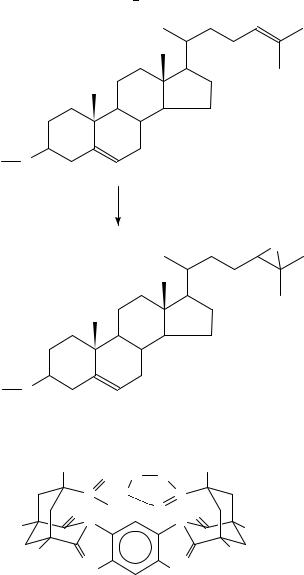
1226 |
Mihaly´ Bartok´ and Gyula Schneider |
process is directed by other functionalities22 26 (e.g. equation 4).
(i-Pr)3 Si O
MCPBA
(4)
O
(i-Pr)3 Si O
For selective epoxidation Rebek and coworkers synthesized highly crowded peroxyacids
(1) and their naphthalene and acridine homologues and compared their epoxidation rates27.
|
Me |
O |
Me |
|
O |
O |
|
|
C |
H |
C |
|
OR |
O |
|
Me |
O N |
|
N O |
|
|
Me |
|
|
|
|
|
|
Me |
|
Me |
|
O |
|
O |
|
Me |
|
Me |
(a) |
R = Me |
(1) |
|
|
|
|
|
(b) |
R = Et |
|
|
The resulting cis/trans ratios for the epoxidation of 2-octenes were 1.2, 5.6 and 7.7 for MCPBA, 1a and 1b, respectively, suggesting a high ratio for the U-shaped peroxy acid
(1). These results indicate that a stereoselective epoxidation is possible by using highly crowded peroxy acids.
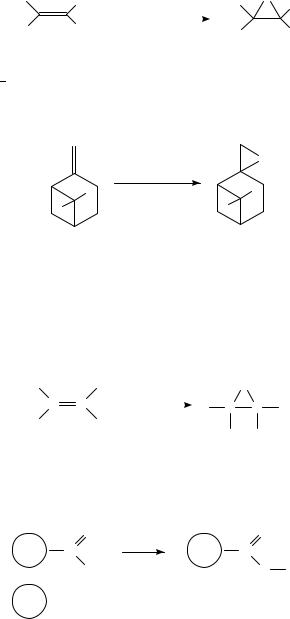
20. Epoxidation of CDX double bonds |
1227 |
The ability of other peracids28, sodium perborate and sodium percarbonate29, to release oxidative species in an organic medium has made them useful reagents in organic synthesis. The oldest organic reaction reported with sodium perborate concerns the formation of peracids (equation 5).
R3 |
R4 |
sodium perborate or |
R3 |
O R4 |
|
|
sodium percarbonate |
|
(5) |
R1 |
R2 |
|
R1 |
R2 |
The formation of peracids as the effective oxidizing species has often been proposed for oxidations with sodium percarbonate in the presence of organic acids or acid anhydrides30 32. It was observed that at room temperature and in dichloromethane as solvent, the addition of acetic anhydride induced the epoxidation by sodium perborate of mono-, diand trisubstituted alkenes, including ˛,ˇ-unsaturated ketones in a slightly exothermic reaction33 (equation 6).
O
sodium perborate
(6)
CH2 Cl2 /A c2 O
New epoxidation methods have been developed by the utilization of alkanesulfonic peracids and peroxymonosulfate34,35.
B. Metal-catalyzed Epoxidations
1. Epoxidation by hydrogen peroxide
Hydrogen peroxide is a mild oxidant and its use in olefin epoxidations requires the application of appropriate catalysts. The oxidation with aqueous hydrogen peroxide in the presence of tungstic acid yields the corresponding epoxides (equation 7)9.
|
|
|
O |
|
C C |
H2 O2 , H2 WO4 |
|
(7) |
|
|
C |
C |
||
|
||||
|
|
|
||
The catalytic epoxidation proceeds via the formation of peroxytungstic acid. Similarly, other metal catalysts are effective in the H2O2 oxidation. Aqueous conditions are not appropriate for epoxidations since epoxides are prone to undergo acid-catalyzed hydrolysis36. Polymer-anchored catalysts are conveniently separated from the reaction mixture after catalyzed H2O2 epoxidations (equation 8)9.
|
O |
|
|
|
O |
|
P |
M |
H2 |
O2 |
P |
M |
|
|
|
|
||||
|
OH |
|
|
|
O OH |
(8) |
P |
= polymer |
|
|
|
|
|
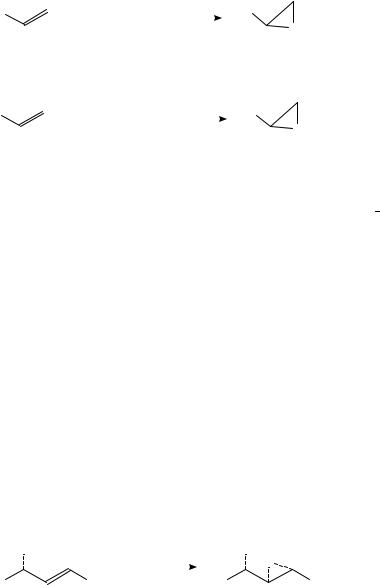
1228 |
Mihaly´ Bartok´ and Gyula Schneider |
Polyoxometalates have been used as homogenous catalysts for a wide variety of thermal organic substrate oxidations37. This involves the epoxidation of relatively electron poor terminal olefins by H2O2 and heteropoly acids, principally H3[PW12O40], using PTC (equation 9).
R |
+ |
H2 O2 |
H3 [PW12 O4 0 ], PTC |
|
|
H2 |
O/CHCl3 |
||
|
|
|
||
R
+ H2 O (9)
O
The transformation in equation 9 is similar operationally and mechanistically to the chemistry described in equation 10 (see in References 9 and 38). Here, biphasic H2O2- based epoxidations of terminal olefins are effected by tungstate and phosphate.
R |
+ |
H2 O2 |
H+, WO4 |
2 −, PO4 3 −, PTC |
|
H2 |
O/CHCl3 |
||
|
|
|
R
+ H2 O (10)
O
Similar results are obtained if tungstate is replaced with tungstic acid, WO3H2O39,40. Under noncatalytic conditions very similar to those in equation 10, the polyperoxometalate fPO4[WO O2 2]4g3 was isolated and characterized crystallographically41. This tetranuclear species was postulated to be the active oxygen transfer agent in equation 10 based on its ability, as an isolated complex, to effect the active epoxidation of terminal olefins42 44. Recently the corresponding Mo analogue fPO4[MoO O2 2]4g3 was isolated and thoroughly characterized45,46. Another polyoxometalate disubstituted with a manganese(II) transition metal, [WZnMn2 ZnW9O34 2]12 , dissolved in an organic solvent by a quaternary ammonium counter cation, was used as a highly effective catalyst for the epoxidation of alkenes47.
2. Epoxidation by hydroperoxides and other oxidants
Olefin epoxidation with alkyl hydroperoxides catalyzed by various metal complexes, e.g. Mo, V and Ti, is an important industrial process9. Despite intensive studies48, the detailed epoxidation mechanism has not been clarified. It seems that two alternative pathways9, A and B in Scheme 1, each involving a metal alkyl peroxidic complex
(2), have been accepted in the literature. Mechanism A involves an electrophilic O- transfer to olefins just like the epoxidation process by peroxy acids49. Mechanism B involves a five-membered dioxametallocyclopentane (3), i.e. it occurs via a pseudocyclic peroxymetalation50,51. For the particular case of vanadium, the alkylperoxy complexes were isolated, and pathway B was supported by the fact that the relative rates were correlated with the coordinating ability of olefins. The operating pathway seems, however, to change by changing metals, ligands and solvents.
High syn diastereofacial selectivity was reported in the formation of the epoxides which are obtained upon epoxidation of -amino-˛,ˇ-unsaturated esters with a reagent derived from potassium t-BuOOH in THF-ammonia52 (equation 11).
Bn2 N |
|
|
Bn2 N |
O |
|
|
|
t-BuOOH |
|
(11) |
|
|
|
|
|
|
|
R |
CO2 Me |
R |
|
CO2 Me |
|
It was found that the cyclic vinyl sulfone with t-BuOOLi yielded only a single stereoisomer. The structure was established as the anti-epoxide by an X-ray crystal structure
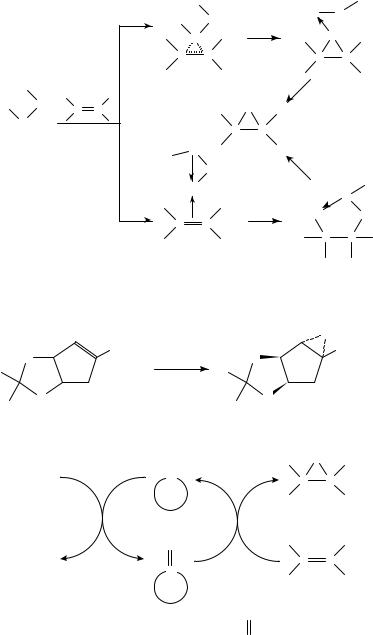
|
|
20. Epoxidation of CDX double bonds |
1229 |
|||
|
|
|
R |
|
|
R |
|
|
A |
M |
O |
M |
O |
|
|
|
|
|||
|
|
|
O |
|
|
O |
|
|
|
|
|
|
|
|
|
|
C |
C |
C |
C |
|
|
|
|
|
||
|
R |
|
|
|
|
|
M |
O |
C C |
|
|
O |
|
|
|
|
|
|
||
|
O |
|
|
|
C C + MOR |
|
|
(2) |
|
|
|
|
|
|
|
O |
|
|
|
|
|
|
|
|
|
|
|
|
|
|
R |
|
|
|
|
|
|
|
O |
|
|
|
|
|
M |
|
|
R |
|
|
|
|
|
O |
|
|
|
|
|
|
|
|
|
|
B |
C |
C |
M |
O |
|
|
|
|
|
||
|
|
|
|
|
C |
C |
|
|
|
|
|
|
(3) |
|
|
|
SCHEME 1 |
|
|
|
determination53 (equation 12). |
|
|
|
|
||
|
|
|
|
|
O |
|
|
O |
SO2 Ph |
|
|
O |
SO2 Ph |
|
|
t-BuOOLi |
|
(12) |
||
|
|
|
|
|
||
|
O |
|
|
|
O |
|
Another type of catalytic epoxidation is the reaction via metallo oxo intermediates (Scheme 2) (see details in Reference 9).
O
TO |
M |
C C |
|
O |
|
|
T |
M |
C |
C |
|
|
|
|
TO = terminal |
O |
represents the formal |
|
oxidant |
|
oxidation state of the |
|
|
M |
metalloporphyrin |
|
SCHEME 2

1230 |
Mihaly´ Bartok´ and Gyula Schneider |
In the last decade, transition metal complexes (e.g. metalloporphyrins) have been used to catalyze epoxidation. These entities can reproduce and mimic all reactions catalyzed by heme-enzymes (cytochromes P-450)54. Synthetic metalloporphyrins are analogous to the prosthetic group of heme-containing enzymes which selectively catalyze various oxidation reactions. The metallo complexes of Fe, Co, Cr, Mn, Al, Zn, Ru, etc. possessing porphyrin ligands have been mostly studied55 57. Porphyrin ligands (4) are planar and can possess several redox states of the central metallic ions and hence they can exist as oxo metals.
|
|
|
(a) |
R = H |
R |
|
R |
(b) |
R = Me |
|
|
|
||
|
N |
|
(c) |
R = |
|
|
|
||
N |
M |
N |
|
|
|
N |
|
(d) |
R = |
R |
|
R |
|
OR′ |
|
|
|
|
|
|
|
|
|
R′ = glycoside |
|
(4) |
|
|
|
The high reactivity |
of |
these catalytic systems |
utilizing oxidants such as |
|
iodosylarenes58 62, peracids63,64, hypochlorites65 70, alkylhydroperoxides71,72, hydrogen peroxide73 75, amine N-oxide76 and ozone77 has been described. The mechanism consists of an oxygen atom transfer from oxometalloporphyrins to alkenes with the ratedetermining step of the formation of a charge-transfer complex64 (Scheme 3).
The reactions following the rate-determining step (epoxidation vs rearrangement) were proposed to be dependent on a number of factors that included the oxidation potentials of the alkenes and the active oxidant, the steric and electronic structures of the reactants (steric bulk and geometry of both species and the metal axial ligand of the metalloporphyrins) as well as the properties of various substrates to undergo rearrangements. Examination of the metal and ligands revealed various features of metalloporphyrincatalyzed epoxidations. Sometimes, the epoxidation was accompanied by rearrangements and isomerizations indicative of a one-electron transfer from olefin to oxo metals78 80. cis-Olefins are more reactive than trans-olefins in porphyrin-catalyzed epoxidation by iodosylbenzene. For example, cis-stilbene is epoxidized by tetraarylporphyrin [Fe(TPP)Cl] (4c,d) in 77% yield whereas trans-stilbene does not react under the same conditions. In contrast, the use of Mn porphyrin yields a mixture of cis and trans isomers81. High selectivity is induced by sufficient noncovalent interactions between the substrate and the metalloporphyrin. The use of NaOCl as oxidant promotes epoxidation in good yields and with high regioand stereoselectivities for terpenes and steroids82. Dienes can selectively be transformed to monoepoxide83.
3. Asymmetric epoxidation
Chiral porphyrins, prepared in different ways84,85 (chiral units attached to preformed porphyrins84, chiral substituents introduced during the synthesis of porphyrins86 or chiral porphyrins synthesized without the introduction of chiral groups69,87 90), proved to be effective as asymmetric epoxidation catalysts.

20. Epoxidation of CDX double bonds |
1231 |
O
+
MV
rate-limiting step
O |
charge-transfer complex |
|
MV
• + |
+ |
|
|
|
|
O |
O |
O |
|
||
MIV |
MIII |
MIV |
|
radicalchain product |
rearrangement |
epoxide |
epoxide |
+ |
products |
|
|
rearrangement product |
|
|
|
|
SCHEME 3 |
|
|
Prochiral olefins, such as ˇ-methylstyrene, can be epoxidized with 72% enantiomeric excess, either with ‘picket’ metalloporphyrins (‘basket handle’ iron-porphyrin)91,92 or with bulky ligand porphyrins93 96. Chiral binaphthyl bridges give a rigid conformation and a chiral environment to the metallic center, which recognizes the substrate84. A serious weak point for the metalloporphyrin-catalyzed epoxidation is the oxidation of the porphyrin rings themselves, resulting in low turnover9. The rings may be moderately stabilized by introducing sterically bulky groups or electron-withdrawing groups97 99.
At present, the best enantiomeric excess with different olefins is achieved by chiral salen ligands100 108. Contrary to the porphyrin systems, salen complexes (5) [i.e. N,N0 - ethylene-bis(salicylidene-aminate) ligands] bear tetravalent and potentially stereogenic carbon centers in the vicinity of the metal binding site.
The reaction of cyclohexene with Mn(III)(salen)/t-BuOOH afforded cyclohexene oxide as the single product in the presence of radical inhibitors. When PhIO was used as the terminal oxidant, stereospecific epoxidation could be attained. Similar results were obtained with Co(II)(salen) (5); stereospecific epoxidation took place with PhIO as the
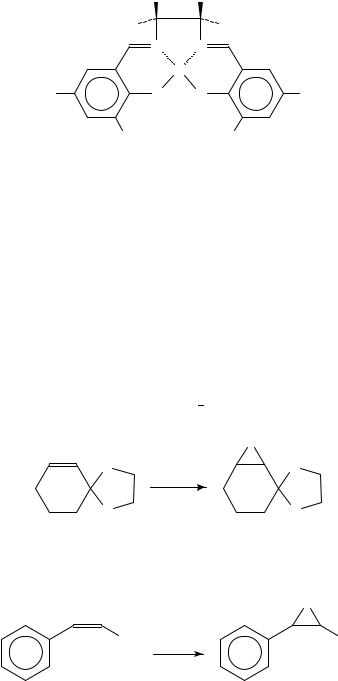
1232 Mihaly´ Bartok´ and Gyula Schneider
|
R |
R′ |
|
|
|
R′ |
|
R |
|
|
N |
N |
7 |
|
|
M |
|
1 |
6 |
|
|
|
||
R2 |
O |
O |
2 |
5 R2 |
|
|
|
3 |
4 |
|
R1 |
|
R1 |
|
|
(5) |
|
|
|
(a)R = R′ = R1 = R2 = R3 = R4 = H
(b)(R, R); R = R2 = H, R′ = Ph, R1 = t-Bu
(c)(S, S); R′ = R2 = H, R = Ph, R1 = t-Bu
terminal oxidant while the epoxidation with t-BuOOH was accompanied by a radical reaction9.
The asymmetric epoxidations of unfunctionalized olefins without coordinating groups are difficult but very interesting. Jacobsen and coworkers were the first to report asymmetric catalysis with chiral Mn(III)(salen) complexes101,109. These systems are generally derived from chiral 1,2-diamino-1,2-diphenylethane. Systematic variation of the steric and electronic nature of different substitutents led to the discovery of catalysts that are particularly effective for the epoxidation10,102 trans-Olefins did not show as good enantioselectivity as cis olefins. The enantiomeric excess (ee) is substrate-dependent and can reach 93%110,111. The most selective catalyst for the epoxidation of a wide range of olefins is the Mn(salen) complex (e.g. 5c)101,111 113 (e.g. equation 13).
|
|
O |
O |
|
O |
|
5c, A rIO |
(13) |
|
|
|
O |
|
O |
In the case of cis-ˇ-methylstyrene the 84% ee is rather high (equation 14), and also significant is the 33% ee for the epoxidation of trans-stilbene for which asymmetry is regarded to be difficult to induce (equation 15).
O
Me |
Me |
(14) |
5b, A rIO
